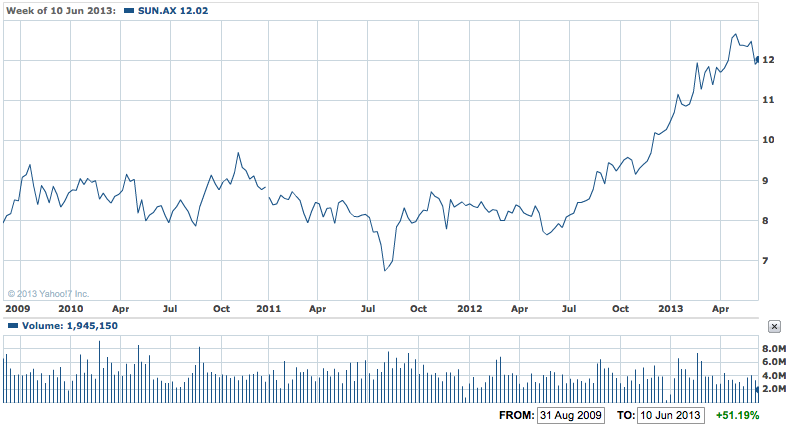Brisbane-based financial services group, Suncorp (SUN), is attempting to clean up its balance sheet and get rid it of its ‘non-core’ or bad bank loans – at a cost of close to half a billion dollars in losses to be reported in the 2012-13 full year results in August.
The deal and further sales will mean Suncorp has finally put the dark days of the GFC and its earlier lending spree on property in Queensland and NSW, behind it.
That lending spree cost the company and its Metway bank billions in dud loans – some were total losses, some were partially impaired, others were OK, but the borrowers needed nursing back to health.
The creation of the bad or non-core bank enabled the bank to take a longer view and convince regulators and the market that it could survive on its own.
At one stage this spending spree and rising costs of fund raising threatened Suncorp’s independence. There were reports that the ANZ or Westpac were eyeing it as the GFC deepened in September 2008 when Lehman Brothers collapsed.
In September 2009 the bad bank was created with $18 billion of dud, non-performing or impaired loans – now it will be reduced to half a billion or less by the end of next month.
Suncorp completing its rebirth from GFC black hole

Now those strained times are behind it and with the insurance side surviving the floods, storms and NZ earthquakes from late 2010 into 2012, the financial services company is taking a final step to complete the clean up.
An announcement yesterday from the company revealed that it now planned to get rid of the non-core assets – mostly dud property loans in NSW and Queensland – by June 2014, with most going in a big deal with Goldman Sachs.
Suncorp said it had sold a $1.6 billion non-performing loan portfolio to Goldman Sachs for 60 cents in the dollar. The sale follows a strategic review of its non-core portfolio which, at the end of May, had an outstanding balance of about $2.8 billion.
Suncorp said it expects another $500 million in further organic run-off and individual loan sales in June and $200 million in July.
That would leave it with another $500 million in 130 residual loans left. That includes 25 loans with balances above $50 million, down from 121 at the establishment of the non-core bank.
To keep Suncorp shareholders happy, chairman Dr Ziggy Switkowski reiterated that the company was considering lifting its target dividend payout range of 60% to 80% of cash earnings to keep it attractive to investors.
He said the resolution of the non-core portfolio marked a significant milestone in the Group’s transformation.
“Resolving the Non-core portfolio over the past four years has been a difficult and challenging experience for the Board, Suncorp management and, of course, our shareholders."
“The reducing scale of the Non-core portfolio and the strength of the Suncorp Group have allowed us to act decisively at this time to remove the Non-core portfolio risk,” Dr Switkowski said.
Dr Switkowski also reiterated that any capital that was surplus to the needs of the Group would be returned to shareholders, a point made by CEO Patrick Snowball in an investor briefing in late May.
In that late May Brisbane-based Suncorp told an investors day briefing that it is now targeting what it calls "top line growth" of 7% to 9% over the next couple of years and wants to boost return on equity to 10% by 2015.
Mr Snowball said that some of this extra growth will come from the company’s continuing cost cutting and process reform called its "simplification program". He says the program will see benefits increase to $225 million in the 2015 financial year and $265 million in 2016.
The bank has around $800 million of excess capital, which could be returned to shareholders. A further $530 million in capital has been applied to shrinking the non-core loan portfolio. That will be mostly chewed up by the losses of up to $490 million.













